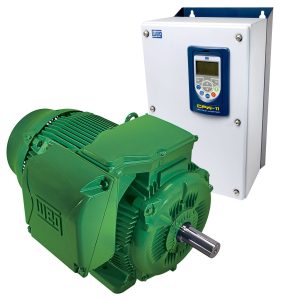~ Supporting environmental compliance in fans, pumps and compressors ~
Today, the most common use of drives in industrial environments is for the control of fans, pumps and compressors. In fact, these applications account for about 75 per cent of all drives operating globally. Here, Marek Lukaszczyk, European and Middle East marketing manager at motor and drive manufacturer WEG explains why overall equipment effectiveness (OEE) and sustainability are closely linked, and how drives are essential for energy efficiency.
Motors and drives shouldn’t be an afterthought in any industrial plant’s sustainability strategy. In reality, they can be vital in helping manufacturers achieve sustainability and CO2 abatement objectives, guaranteeing environmental compliance and driving efficiency throughout the plant. Let’s look more closely at how motors and drives can support more sustainable performance in fans, pumps and compressors.
Compressors
Compressors are used to blow and transfer products around a factory, be it foods, pharmaceuticals or plastics. Indeed, compressors are so ubiquitous in powering processes and machines that compressed air has been called the fourth utility for manufacturing products ― alongside water, gas and electricity.
However, it’s well-documented that air-handling equipment is capable of consuming large amounts of energy. How do motors and drives improve OEE and sustainability in these applications?
It is possible to better manage a compressor’s energy use — and also extend the service life of a motor — by gradually accelerating it from a standstill using a variable speed drive (VSD). In cases where a VSD isn’t used, the motor will start instantly with a large current, which can be highly detrimental to motor longevity.
Instead, a VSD can automatically adjust the motor speed to suit the air demand. Estimates vary, but in terms of energy savings, using a VSD compressor in comparison to a fixed speed, idling or load/unload compressor, could comfortably produce energy savings of 35 to 50 per cent.
The motor’s operating temperature should also be considered. Bearings in the motor last longer at lower operating temperatures, which gives lower maintenance costs and bottom line savings. To this end, WEG recommends its W22 Magnet IE5 Ultra-Premium motor, which is shown to give 34 per cent efficiency savings against competing units.
Pumps
Pumps are used in water supply systems, chemical manufacturing, and food and beverage applications. They are also used to keep oil flowing under high pressure and efficiently, through long pipelines. However, the electric motors used are often too inefficient or improperly sized to keep the oil flowing under high pressure.
Instead, by using a VSD to slow the fan or pump motor from 100 per cent to 80 per cent, it’s possible to save up-to 50 per cent of the energy used. What’s more, these savings continue to multiply in proportion and help extend the service life. And further advantages can be achieved by applying Industry 4.0 technologies.
A sensor that might otherwise be used to monitor a drive or motor can also be retrofitted to other equipment, including pumps. Examples include the WEG Motion Fleet Management platform that, combined with WEG Motor Scan sensors linked to motors and drives, makes it possible to evaluate the frequency and duration of problems, and source their origin, to support predictive maintenance.
Fans
Industrial fans currently use 300 Terawatt-hours (TWh) per year in electricity, which makes it the third-largest electricity consumer after industrial motors and light sources. Meanwhile, the Commission Regulation (EU) 327/2011 will put forward new ecodesign requirements for fans driven by motors with an electric input power between 125 W and 500 kW. The EC reports that its EU 327/2011 measures could support energy savings in fans of up to 24 TWh/year in 2030.
To help meet these regulations, VSDs are the ideal choice for when complete speed control is optimal. Take food processing, for instance, where changing cooking temperatures require fans that continually adjust to cool the environment accordingly. For this application, a VSD would be the best choice because controlling the fan’s speed is the primary concern.
VSDs also flexibly reduce or increase power depending on whether it’s needed. This helps optimise OEE when equipment is used for multiple purposes, and greatly helps manufacturers’ sustainability objectives.
It is essential to choose the right motors and drives for optimised OEE in a given application. In doing so, your motors and drives can be integral to environmental compliance and driving efficiency in fans, pumps and compressors ― and throughout your entire plant.



